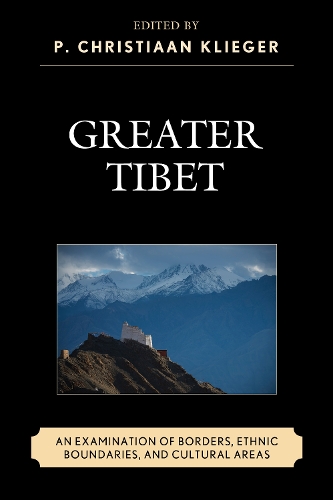
Greater Tibet: An Examination of Borders, Ethnic Boundaries, and Cultural Areas
(Paperback)
Available Formats
Publishing Details
Greater Tibet: An Examination of Borders, Ethnic Boundaries, and Cultural Areas
By (Author) P. Christiaan Klieger
Contributions by Namgyal Choedup
Contributions by Hanung Kim
Contributions by P. Christiaan Klieger
Contributions by Sergius L. Kuzmin
Contributions by Seokbae Lee
Contributions by Jan Magnusson
Contributions by Max Oidtmann
Contributions by Telo Tulku Rinpoche
Contributions by Tenzin N. Tethong
Bloomsbury Publishing PLC
Lexington Books
11th April 2019
United States
Classifications
Professional and Scholarly
Non Fiction
Cultural studies
301.09515
Physical Properties
Paperback
178
Width 150mm, Height 223mm, Spine 13mm
277g
Description
The concept of Greater Tibet has surfaced in the political and academic worlds in recent years. It is based in the inadequacies of other definitions of what constitutes the historical and modern worlds in which Tibetan people, ideas, and culture occupy. This collection of papers is inspired by a panel on Greater Tibet held at the XIIIth meeting of the International Association of Tibet Studies in Ulaan Baatar in 2013. Participants included leading Tibet scholars, experts in international law, and Tibetan officials. Greater Tibet is inclusive of all peoples who generally speak languages from the Tibetan branch of the Tibeto-Burman family, have a concept of mutual origination, and share some common historical narratives. It includes a wide area, including peoples from the Central Asian Republics, Pakistan, India, Nepal Bhutan, Bangladesh, Myanmar, Peoples Republic of China, Mongolia, Russia, and Tibetan people in diaspora abroad. It may even include practitioners of Tibetan Buddhism who are not of Tibetan origin, and Tibetan peoples who do not practice Buddhism. Most of this area corresponds to the broad expansion of Tibetan culture and political control in the 7th9th centuries AD, and is thus many times larger than the current Tibet Autonomous Region in Chinathe Tibetan culture area. As a conceptual framework, Greater Tibet stands in contrast to Scotts concept of Zomia for roughly the same region, a term which defines an area of highland Asia and Southeast Asia characterized by disdain for rule from distant centers, failed state formation, anarchist, and libertarian individual proclivities.
Reviews
One of the most insightful and extensive academic publications on the theme of Tibet this year, Greater Tibet explores notions of borders, identity and culture, spanning a region far larger than current political parameters. Inspired by a panel held at the thirteenth meeting of the International Association of Tibet Studies in Ulaan Baatar during 2013, and derived from the extensive knowledge of Tibet-related experts, Klieger has brought together a fascinating publication and a must-read for academics and enthusiasts alike. * Tibet Foundation Newsletter *
This fascinating collection of studies ranges in geographical scope and temporal depth to demonstrate the value of using the concept of a Greater Tibet to challenge academic and political narratives on what constitutes a nation or state, and to shed light on how people living at the social, economic, and political margins of powerful states navigate complex issues of identity. -- Geoff Childs, Washington University
Christiaan Klieger has succeeded in placing the Tibetan civilizational world at the center, thereby countering decades of political propaganda that relegated the Tibetan nation to the periphery of Chinese empires and states. The diversity of approaches to and understandings of Tibetin that nations broadest cultural, religious, ethnic, and historical imaginingsreflected in this volume, challenges the often one-dimensional characterizations of Tibet in history and in the present. -- Michael C. Van Walt van Praag, Sapienza University of Rome
This volume is an invaluable introduction to new approaches to the study of Tibet in the widest sense of the word. By adopting a borderlands perspective and conducting research in regions ranging from Mongolia to Myanmar, Buryatia to Bhutan, the contributors address the question: Where does Tibet begin and end Their answers provide an important corrective to narrower and politicized definitions generated both in the past and the present. -- Clare Harris, University of Oxford
Author Bio
P. Christiaan Klieger is an anthropologist who has taught at University of Hawai'i, University of Pittsburgh, and Chaminade University of Honolulu.
